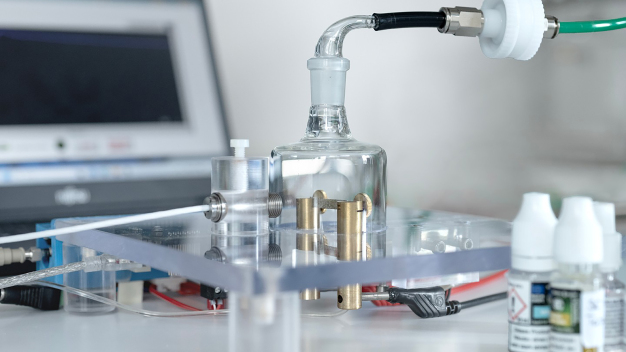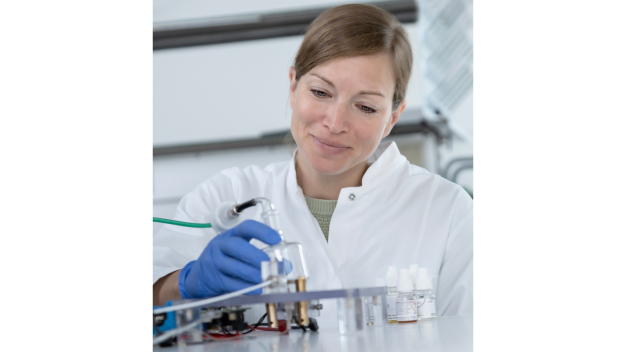- Science
EVape helps improve consumer safety in the e-cigarette segment
Toxicology
Electronic cigarettes, or vapes, are commonly viewed as less harmful to people’s health than tobacco cigarettes. And yet, they are not without health drawbacks. For many ingredients, it is unknown how they will behave when heated. Since the temperatures inside e-cigarettes vary widely, different products can be released during thermal decomposition. This makes it more difficult to gauge the potential risks of these tobacco alternatives. Until now, there has been no testing system that could be used to test the ingredients used across the entire relevant temperature range. Now, with EVape, the Fraunhofer Institute for Toxicology and Experimental Medicine ITEM has developed a prototype device for controlled vaporization of e-liquids in a broad temperature range. The emissions released during the process can then be analyzed and subjected to a toxicological assessment. The findings are generally valid, regardless of which e-cigarette the liquid is used in.
Vapes are increasingly popular and these days can be found in many different places, from supermarkets to kiosks and gas stations. There is a broad selection, encompassing many different models, flavors, and liquids. The sheer variety makes it difficult to assess the health risks posed by e-cigarettes in general. Under Germany’s Ordinance on Tobacco Products (Tabakerzeugnisverordnung, TabakerzV), the liquids used in electronic cigarettes must not pose a risk to human health when either heated or not. However, for many ingredients, it is unknown how they will behave when heated. The vaporization of the liquids could release components that are problematic from a health perspective — especially if they contain substances that are considered safe when consumed orally or inhaled but break down into other substances with potentially concerning toxicological profiles when heated. Further study is needed for a number of additives and food flavorings that are intended to improve the taste of e-cigarettes, which are made mainly of glycerin, propylene glycol, and nicotine. “Nicotine is stable when exposed to high temperatures. It keeps its molecular structure when heated to 500 degrees Celsius. Other additives are different, though. One example is sucralose, a sweetener that is also used in e-liquids, or vape juice. Sucralose is sensitive to temperature. It breaks down at just 120 degrees Celsius and forms substances that are carcinogenic. That’s why more and more e-liquid manufacturers are eliminating it from their products,” says Dr. Stefanie Scheffler, a scientist at Fraunhofer ITEM in Hannover. She and her team are working to improve consumer safety for e-cigarettes, since many additives have not yet been studied adequately.
EVape ensures vaporization under controlled conditions
With EVape, the researchers have now developed a patented system that can be used to test e-liquids across the entire relevant temperature range. This was previously impossible but it is very important, because a toxicological risk assessment needs to take into account the fact that the temperature inside e-cigarettes varies widely depending on the model and built-in battery. As a result, the fission or thermal decomposition products produced by different e-cigarettes can vary as well. While manufacturers are required to disclose toxicology data for the liquids and their emissions, the information is generated using different commercially available e-cigarettes with diverse temperature profiles, so the results are not universally valid or comparable. With that in mind, the team set out to test the ingredients used across the entire relevant temperature range, from 150 to 350 degrees Celsius. Right now, however, there is no test system that enables this extensive testing scenario and covers the entire temperature range. The researchers at Fraunhofer ITEM intend to close this gap with EVape: The portable lab device, which can be hooked up to standard analysis equipment, ensures that vaporization takes place under controlled conditions, so the results are independent of the e-cigarette used, making them comparable.
Testing of various commercially available e-liquids at different temperatures is performed under real-life conditions: The e-liquid is vaporized suddenly while being exposed to normal air from the surroundings. Continuous real-time measurement of the temperature keeps the liquid from overheating during the tests. “We apply small amounts of the liquid to a hot heating surface, so it instantly vaporizes. Then the vapor is sucked off and can be analyzed to see what substances are in it. They can be compared against the substances analyzed from before the vaporization process to gain information about the thermostability of those substances,” says Scheffler, describing the testing process. Initial results show that the spectrum of substances found depends on temperature.
Standardized checks to improve e-liquid quality
EVape offers manufacturers ways to rule out potentially harmful substances even before they produce their e-liquids. It allows them to quickly and effectively generate toxicological profiles for e-liquids, limit them to or approve them for certain temperature ranges, and identify all of the emissions generated under realistic conditions through continuous real-time measurements of temperature. Beyond that, the researchers also hope EVape will help regulatory authorities monitor the e-cigarette liquids available on the market. “We plan to license EVape in the future and make it available to labs, regulatory authorities, and industry. Our goal is for EVape to be used as a reference device so e-liquids don’t reach the market before being tested using our testing system.”
Fraunhofer-Institut für Toxikologie und Experimentelle Medizin ITEM
30625 Hannover
Germany










